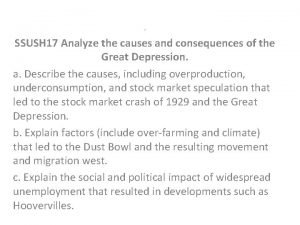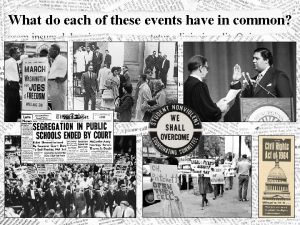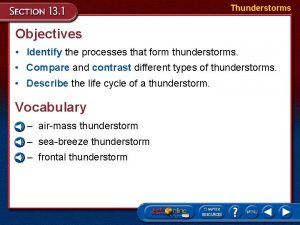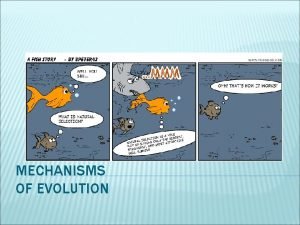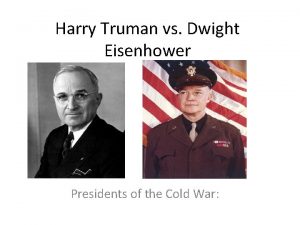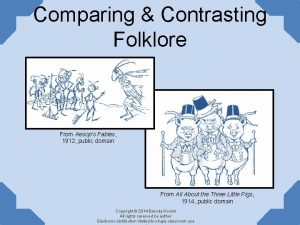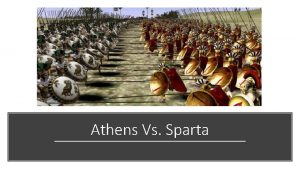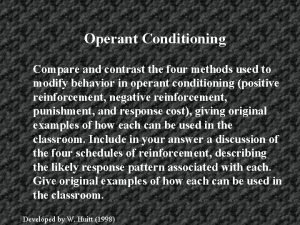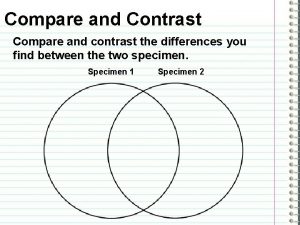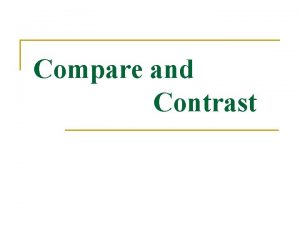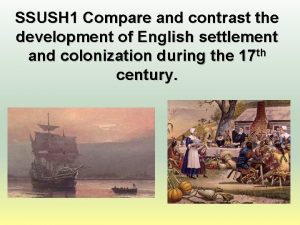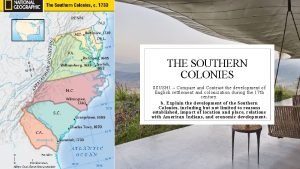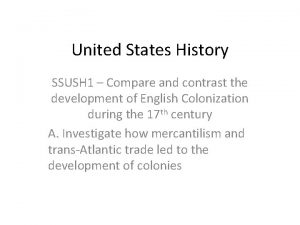SSUSH 1 Compare and contrast the development of












































- Slides: 44

SSUSH 1 Compare and contrast the development of English settlement and colonization during the 17 th century

th 17 Century East Coast

1. a- Investigate how mercantilism and trans-Atlantic trade led to the development of colonies • Mercantilism describes the economic systems emerging in Europe in conjunction with the early colonial era (1450 s-1700 s). Mercantilism correlated a nation’s power with wealth- especially the accumulation of gold and silver through favorable trade balances. In other words, under a mercantilist economic system, the idea was to accrue wealth by selling more goods to others than you buy from them. • This led to fierce competition between European powers for access to and control of trade. Competition between the major European powers. Spain, Portugal, England France and Holland- intensified dramatically following Columbus and the beginnings of colonization in the Americas. Spain and Portugal had a nearly 100 year head start on England, and in order to successfully challenge and overtake the Iberians as a dominant power in Europe, the English knew they needed to establish overseas colonies.

Mercantilism and colonies • Colonies, and the commodities they produced were very important to mercantilism- both for the raw materials they produced for the mother country and eventually as markets for goods from the mother country. • Aside from the enormous influx of gold and silver from the Spanish conquest of the Aztec and Inca and subsequent mining efforts, by far the single most important commodity developed in the Americas was sugar. The sugar colonies established by Spain and Portugal were enormously profitable and set into motion the competition between European nations to establish colonies in the Americas.

Mercantilism and the English Colonies • As a mercantilist framework came to dominate the European economy and define relations between European powers, England became acutely aware of its need to establish colonies. • England’s earliest efforts in the Americas, such as the John Cabot expedition in 1497, established some claims to land fishing grounds but not much else. England again attempted to make good on their North American claims in the late 1500 s, establishing a tiny outpost of colonists on Roanoke Island (present North Carolina). When a ship returned to resupply the colony, the colonists were gone. Historians still speculate on what happened to this “Lost Colony”

• After the failed colony of Roanoke, the English again attempted to establish a North American colony in 1607. • Jamestown was the first permanent English settlement in North America. After a disastrous start, the Virginia colony gave the English a foothold in North America and established a model for future colonial ventures in North America.


Trans-Atlantic Trade • Trans-Atlantic trade describes the exchange of goods between Europe, their colonies in the Americas, and west Africa. • Also known as “triangle” trade, because of the three areas involved • In simplified terms this “triangle” trade involved: raw goods produced in American colonies, often with enslaved labor from Africa, to be refined/finished/manufactured, then sold, by and for the benefit of the mother nation.

w

1. b- Explain the development of the Southern Colonies, including but not limited to reasons established, impact of location and place, relations with American Indians, and economic development • The “Southern Colonies” refers to the group of English North American colonies including Virginia, Maryland, North Carolina, South Carolina, and Georgia. • These colonies share a common historical legacy because of the similarities of their establishment, geography, relations with Indians, and economic development.


Reason established • As discussed, in the big picture, the reason the English wanted to establish colonies in the Americas had to do with mercantilism and the ongoing rivalry with the Spanish and other European rivals. • However, the immediate reason for the establishment of the first English colony in North America, Virginia, was more narrow. The colony was a venture of the Virginia Company, a joint-stock company chartered by the Crown, but initially controlled by a group London merchants who wanted to make a profit for the company and the English Crown. Agricultural commodities would come to dominate the Southern Colonies

Virginia Company Seal

First English Colony- Jamestown • In 1607 the English established their first successful colony at Jamestown, on the James River- The earliest colonists nearly starved to death. The colony’s existence was ensured by its first profitable commodity- tobacco.

Reasons Established • The other southern colonies following Virginia, with some variance, were established for similar reasons (economic), and developed similar economic bases (agricultural products for export back to England). • Maryland (1634) and North Carolina (1650 s) essentially extended the success of tobacco culture established in Virginia. South Carolina (1670) was established by a group of Barbadian planters who eventually developed rice as their principle export. Georgia (1733) although initially established as a buffer between Carolina and Spanish Florida eventually followed South Carolina into rice production. • One additional and notable reason for the establishment of Maryland was to serve as a haven for English Catholics, who were suffering intense persecution in England during the 1630 s.

Impact of location and place: Southern Colonies • As with all human endeavor, geography played an extremely important part in the development of the Southern Colonies. Since the colonies were intended to provide goods for England, access to the Atlantic was paramount. The largest and most important settlements were all coastal towns with serviceable ports and harbors. The broad coastal plains and extensive systems of navigable rivers allowed settlements to extend deep into the interior of the Southern Colonies. • The humid sub-tropical climate of the Southern Colonies allowed for a long growing season and contributed to the development of agriculture as the economic base of this region. This climate also left the southern colonists more susceptible to disease. Mosquito-borne illness like malaria and yellow fever plagued southern settlers throughout the colonial era.

Native Americans • The earliest settlers at Jamestown depended on food traded with Native Americans in the region- the so-called Powhatan confederacy- a group of affiliated Algonquin speakers named for its leader at the time, a chief named Powhatan. • Initially cordial relations between the Virginians and the Indians soured after a wave of immigration expanded the English settlements, encroaching on land controlled by the Powhatan. • In 1622 Native Americans attacked Jamestown, killing 350, and nearly wiping the colony out. In response, the Crown revoked the Virginia Company’s charter and established Virginia as a royal colony under its direct control. • Intermittent warfare with the Powhatans continued to erupt through the 1640 s. By that time the number of English settlers had dramatically increased and the Indians found it increasingly difficult to resist English expansion.

Powhatan • A depiction of Powhatan- leader of a confederacy of Native settlements near the Jamestown colony.

Native Americans • The relations with Native Americans in the rest of the southern colonies typically followed the pattern established by the Virginians, i. e. , some early examples of cooperation gave way to warfare and eventual dominance by the English as their colonies expanded westward. A series of wars in the early 1700 s (Tuscarora War, Yemasee War) crushed Indian resistance in the areas then settled by the English. • By the time Georgia was founded in 1733, Tomochichi and the Yamacraw had little choice but to cooperate with Oglethorpe and the English. • It should also be noted that throughout the colonies, relations with Native Americans were strongly influenced by economic factors. Indians served both as a supplier of goods- furs, hides and slaves- and as a market for English goods- metal implements, beads, textiles, and firearms.

Economic development: tobacco • A European market for tobacco was already established by the Spanish, prior to the founding of Jamestown. • John Rolfe is credited with developing varieties of tobacco that would grow well in Virginia and sell well in England • In 1614 Rolfe shipped 2600 pounds to England, Jamestown’s first profitable commodity. Soon tobacco was being widely grown throughout the region.

Economic development: servitude and slavery • • As tobacco cultivation spread in Virginia there was a increased need for labor. Early on in Virginia these labor needs were met through indentured servants, along with both Indian and African slaves. Eventually, African slaves would come to be the primary source of labor on tobacco plantations and in similar ventures in the subsequent Southern Colonies. Indentured servants were people who bought passage to the colonies in exchange for a number of years of service- after their service ended they were free to own land start their own farms The first group of twenty Africans were purchased from a Dutch slave trader in 1619. Notably, they were considered “Christian servants” not slaves as such. Early on, Africans in Virginia would have toiled side-by-side with indentured servants, enslaved Indians, and “free” colonists. When economic conditions in England improved and the number of indentured servants decreased, the Virginians turned more exclusively to African slavery to meet labor needs.

Slavery and Tobacco • This depiction of a colonial tobacco plantation shows Virginia colonists overseeing slave labor. Notice the romantic depiction of the Native American’s gift of tobacco at top

Economic development in other Southern Colonies • The Southern Colonies established subsequent to Virginia followed their lead in developing plantation agriculture as the primary economic activity. Tobacco also came to dominate in Maryland North Carolina additionally developed an important industry in timber and naval stores. • South Carolina initially depended on deerskins and Indian slaves before developing rice cultivation in the early 1700 s. In Georgia, early experimentation with silk production eventually gave way to rice and indigo. Because Georgia was envisioned as a buffer between Spanish Florida and the English in Carolina, slavery was banned for the first 20 or so years of the colony. But as the Spanish threat subsided Georgians followed the South Carolinians in establishing rice plantations utilizing enslaved labor.

Bacon’s Rebellion • By the 1670 s- a land crisis was developing among the Virginia colonists- Backcountry farmers were angered by the colony’s refusal to obtain more land from the Native Americans. • Nathaniel Bacon organized a group of these farmers, mostly new immigrants or former indentured servants, to take the land by force, attacking the Native Americans. • Bacon led a short-lived coup that overthrew the leadership of the Virginia colony, but died shortly afterward, and the colonial government was restored.

Nathaniel Bacon • In 1676, Nathaniel Bacon led a rebellion of backcountry farmers, who were upset about the lack of land available on the rapidly expanding Virginia frontier

1. c- Explain the development of the New England Colonies, including but not limited to reasons established, impact of location and place, relations with American Indians, and economic development • The New England colonies included Massachusetts, Connecticut, Rhode Island, New Hampshire, and Maine (part of Massachusetts until 1820). Vermont is now also considered part of New England, but was not organized as such during the colonial era. • Because of the circumstances of their founding and the role of geography, these colonies developed in different ways from their southern counterparts.


Reasons established • Unlike Virginia, New England’s colonies were established primarily for religious reasons • Conflict in England created a schism in the Anglican Church- One group to emerge called themselves the Puritans, because they wanted to “purify” the Anglican Church from any vestige of Catholicism- the Pilgrims, a separatist faction of the Puritans, established a colony at Plymouth in 1620 • The separatists wanted a complete separation from the Church of England. The Crown viewed this as a challenge to its authority and persecuted separatists, leading some to flee England to begin a new life in North America

Puritans- “City Upon a Hill” • John Winthrop- a wealthy Puritan organized a charter for the Massachusetts Bay Company in 1629, which was seen as a haven for Puritans wishing to leave England. By 1643, an estimated 20, 000 colonists had arrived in New England. • Winthrop saw the colony as an example to England the world, of pious, righteous livingsaying that the colony “shall be like a City upon a Hill”

John Winthrop • Founder and early leader of the Puritan haven, Massachusetts Bay Colony- Winthrop called the colony “a City upon a Hill”

Impact of location and place: New England • The geography and climate of New England is substantially different than that of the southern colonies. • Although there were some productive agricultural areas, the soils across much of New England are thin and rocky, and the more northerly situation allowed for much shorter growing seasons. As a result, large scale plantation agriculture was not economically viable. • Moreover, because the fall line of the Appalachians are much closer to the coast compared to the southern colonies, the riparian systems in New England tend to be far more narrow and swift, and less navigable to the interior.

Relations with American Indians: New England • As in Virginia, tenuously friendly relations with Native Americans early on gave way to war as the New England colonies expanded and encroached on Native-controlled lands • A key turning point in Native American history in New England was King Philips’ War (1675 -1678), which broke Native power in the region • Metacom, (King Philip) was a leader of the Wampanoag, and led the uprising in response to the execution of three Wampanoags accused of murder by the English. • Indian relations in New England was also marked by what was arguably the most concerted efforts by any of the English colonies to Christianize the Native Americans. New Englanders established socalled “Praying Towns” in the effort to convert Indians to Christianity, although these efforts largely subsided following King Philip’s War.

New England Natives


Economic development: New England • • Because of its geography, New England’s economy developed quite differently from the plantation agriculture that dominated in the south. Much of New England’s early economy activities were centered around maritime pursuits like fishing and whaling. The Grand Banks off the New England coast was/is one of the most productive fisheries in the world. Salted cod became an especially important commodity in New England because it could be preserved in barrels and shipped to English markets. These activities also led to a thriving shipbuilding and sea merchant economy. Ships’ captains in New England developed a very lucrative variant of “triangle” trade that involved trading rum for slaves in Africa, trading slaves for sugar in the Caribbean, and processing the sugar in domestic New England distilleries. The fur trade and the conveyance of English goods to Native Americans were also important economic activities in New England. In contrast to the monocultures that tended to develop in the southern colonies, New England had a much more diversified and integrated economy, aided by the fact that settlements were organized into towns rather than largely selfsufficient plantations.

1. d- Explain the development of the Middle Colonies, including but not limited to reasons established, impact of location and place, relations with American Indians, and economic development • As the colonies in Virginia and New England prospered and expanded, the English established other colonies along the eastern seaboard. The “middle colonies, ” (named for their geographic position between the established settlements at Virginia and New England) included New York, New Jersey, Pennsylvania and Delaware. These areas had ample cultivable land populations there grew rapidly.


Reasons established: Mid. Atlantic Colonies • In contrast to the southern colonies and New England, areas of the middle colonies were colonized by other European powers prior to the English. The Netherlands (Holland) established fur trading outposts along the Hudson River and even Sweden established a short lived colony in the region of the Delaware River. The Swedish colony was eventually subsumed by the more substantial Dutch presence. • But unlike the rapidly growing English colonies to the north and south, the population of the Dutch North American colonies remained small and in 1664 the English successfully overtook the Dutch holdings. Thus, New Amsterdam became New York, and the English further organized former Dutch lands into what became the colonies of New Jersey and Delaware.

New Amsterdam/New York • First established as an outpost for the Dutch fur trading operation in the Hudson River Valley, overtaken by the English and renamed New York in 1664

New Amsterdam/New York • England seized the Dutch colony in 1664, renaming it New York • New Jersey was established at the same time, offering colonists land grants, along with religious freedoms and the right to an elected legislative assembly

Reasons established: Pennsylvania • To settle a debt, King Charles II granted William Penn a large tract of land between New Jersey and Maryland. • Penn was a Quaker, a radical religious sect at odds with the King and other English denominations • Pennsylvania was established as a “holy experiment, ” a haven for Quakers and others, where complete religious and political toleration would be practiced. • Penn practiced what he preached with regard to fairness with Native Americans- He bought land from Natives in a 1682 treaty and the colony coexisted alongside Native settlements for over 70 years • Availability of land attracted numerous settlers, and by 1700, Philadelphia rivaled New York and Boston as a center of Anglo. American commerce

Impact of location and place: Mid -Atlantic colonies • Much of the middle colonies contained very productive arable lands. Though not necessarily suited for plantation agriculture, the middle colonies developed far more grain and livestock production, so that in the later colonial era it became known as the “breadbasket” of British North America. And as in New England, the coastal towns in the middle colonies developed commercial endeavors, maritime trade, and a far more diversified economy than their southern neighbors.

Relations with American Indians. Mid-Atlantic Colonies • Although not totally without conflict, relations with Native Americans through the mid-Atlantic colonies tended to be more stable than in New England or the South. • This is attributable to several factors. In the fur trading regions along the Hudson and into the Great Lakes region, it was in the interest of colonists to maintain more or less friendly relations with the Indians because they depended on Indian labor to procure furs for trade. • And as mentioned, in Pennsylvania, friendly and equitable relations with the Indians was ensconced in official policy, as a part of William Penn’s “holy experiment” informed by his Quakerism. • Finally, relations with Indians were generally less hostile in this region because by the time large numbers of colonists arrived, disease and warfare had already displaced and/or drastically reduced the number of Indian settlements in the region, especially along the coast.

Economic development: Mid. Atlantic Colonies • • The colonial economy of the mid-Atlantic region incorporated some aspects of economic activities from both their southern and New England neighbors. Agriculture was of prime importance, but instead of tobacco and rice, mid. Atlantic colonists tended to grow cereal crops like wheat, corn, barley, rye, and oats. Raising livestock was also an important agricultural activity in the region. Compared to New England, the farms tended to be much larger, and consistently produced surpluses which could be sold to markets within the colonies, in the West Indies, or in England. Many of the larger farms in the mid-Atlantic made use of indentured and enslaved labor, though not nearly as extensively as in the Southern colonies. As in New England, large towns developed along the mid-Atlantic coast, and these became centers of commerce for shipping, shipbuilding and manufacturing. Servants and slaves were also used in these more urban settings, typically as skilled workers, (shipwrights, carpenters, etc. ) or household servants. .
 Patterns of development exemplification examples
Patterns of development exemplification examples Which of the
Which of the West side story, romeo and juliet comparison chart
West side story, romeo and juliet comparison chart Ssush
Ssush Ssush
Ssush Ssush
Ssush Ssush
Ssush Ssush
Ssush Vertical integration
Vertical integration Ssush
Ssush What was the purpose of the sibley commission
What was the purpose of the sibley commission Compression and rarefaction
Compression and rarefaction High tide
High tide Compare and contrast cold wave and wind chill factor
Compare and contrast cold wave and wind chill factor Compare and contrast narrative expository and explanatory
Compare and contrast narrative expository and explanatory Compare and contrast weather
Compare and contrast weather Venn diagram of hurricanes and tornadoes
Venn diagram of hurricanes and tornadoes Venn diagram of zaroff and rainsford
Venn diagram of zaroff and rainsford Transverse and longitudnal waves
Transverse and longitudnal waves Compare and contrast chemical and physical changes
Compare and contrast chemical and physical changes Compare and contrast gradualism and punctuated equilibrium
Compare and contrast gradualism and punctuated equilibrium Macbeth information
Macbeth information Compare and contrast macbeth
Compare and contrast macbeth Malcolm quotes macbeth act 1
Malcolm quotes macbeth act 1 Pakistan is known for its unique vocals
Pakistan is known for its unique vocals Truman vs eisenhower
Truman vs eisenhower Draco malfoy traits
Draco malfoy traits Immigration definition biology
Immigration definition biology Tanka formula
Tanka formula Compare and contrast mutualism and parasitism
Compare and contrast mutualism and parasitism Concept of biosphere ppt
Concept of biosphere ppt Linear vs exponential functions
Linear vs exponential functions Self ideal e self real
Self ideal e self real Ants and grasshopper similarities
Ants and grasshopper similarities Compare and contrast buddhism and christianity essay
Compare and contrast buddhism and christianity essay Compare and contrast frida kahlo and diego rivera
Compare and contrast frida kahlo and diego rivera Compare and contrast the bach and marsalis families
Compare and contrast the bach and marsalis families Similarities between because of winn-dixie book and movie
Similarities between because of winn-dixie book and movie Compare and contrast athens and sparta
Compare and contrast athens and sparta Compare sparta and athens
Compare sparta and athens Compare sparta and athens
Compare sparta and athens Compare and contrast, karl marx and adam smith venn diagram
Compare and contrast, karl marx and adam smith venn diagram Fission or fusion
Fission or fusion Fixed interval schedule example
Fixed interval schedule example Mixture vs solution
Mixture vs solution



